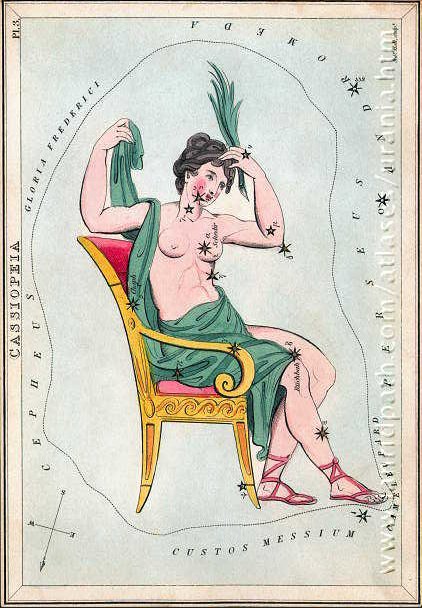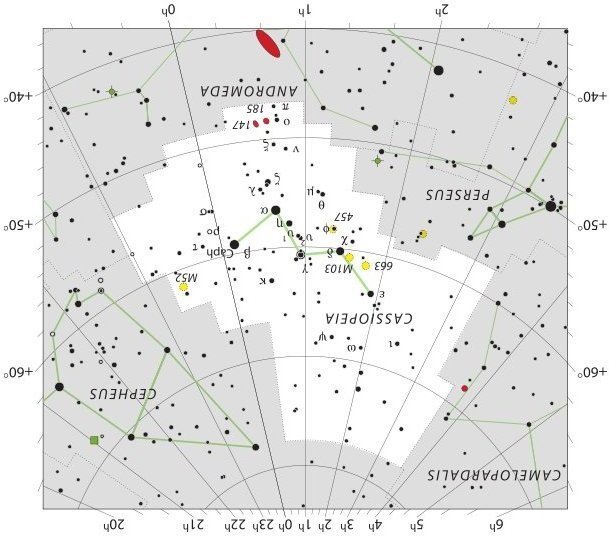4. Let us look in another direction, it has suddenly become much too complicated. Achird is η Cassiopejae, a star not far from α and 46 minutes beyond 00h:
The name of α is Schedir and according to Urania's Mirror this star is at the left breast of the queen:
Caph (β) is rising earlier than α and η and is said (according to Allen) to mark a corner of her chair. Thus the pictures are oriented with higher right ascension to the right instead of to the left (in contrast to the star chart above). The orientation of the queen is peculiar, she must be upside down because Cepheus is at her left and Andromeda is above her, we can see in the picture. Possibly it is the same type of sign which defines where Spring Mars is turned upside down:
According to Flamsteed Schedir is higher up, on her chest below her chin:
It is no easy task to locate Achird in these pictures, because right ascension increases from left to right and declination from top down. Her knee is δ (Ruchbah in Urania's Mirror), and this star is closer to the pole than α (Schedir). It is not enough to mirror the star chart in order to get higher right ascension to the right, we must turn the chart upside down:
Turning the chart upside down will also result in right ascension increasing towards the right. Now at last we have the proper orientation, with Caph where her chair is beginning and with Achird lower down (although with a higher declination) than Schedir. If Schedir marks her left breast, then Achird will be at her stomach. But in Flamsteed Schedir is under her chin and Achird at her left breast. Allen: "Schedar is first found in the Alfonsine Tables, and was Schedir with Hevelius; Shadar, Schedar, Shedar, Sheder, Seder, Shedia, Zedron, etc., elsewhere; and all supposed to be from Al Sadr, the Breast, which this star marks in the figure. Some, however, have asserted that they are from the Persian Shuter for the constellation." Considering our recent discovery that Regulus could be also at the same day as Achird, I guess Flamsteed was right - a newborn baby and his mother's breast are inseparable. And to support my idea I will quote another passage from Allen: "Schiller's Wallenstein, as versified by Coleridge, has That one // White stain of light, that single glimmering yonder, // Is from Cassiopeia, and therein // Is Jupiter - a blunder on the part of the translator that has puzzled many, as 'therein' should be 'beyond' or 'in that direction', but even then what did the poet have in mind?" Inside Cassiopeia ('therein') could be the Jupiter baby waiting for the proper moment to be reborn. Or he has already been delivered and is lying at her breast. Precession and other circumstances will change the exact interpretation. Allen again: "Regulus was so called by Copernicus, not after the celebrated consul of the 1st Punic war, as Burritt and others have asserted, but as a diminutive of the earlier Rex ..." Thus Regulus is a little king. |









